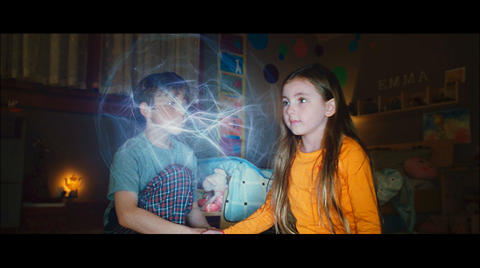Invoking Lewis Carroll, E.T. and Tibetan Buddhism, The Last Mimzy is an overstuffed yet warmhearted sci-fi drama about a dying planet, resourceful kids and a science teacher firmly in touch with his spiritual side.
Adapted from Lewis Padgett's Jabberwocky-inspired short story, Mimsy Were the Borogoves, the movie follows a pair of wide-eyed siblings, Noah and Emma Wilder (Chris O'Neil and Rhiannon Leigh Wryn), who find a mysterious box on the beach of their Seattle summer home. Among its contents are a stuffed rabbit and some strange crystals, and as the children play with them, they begin to develop unsettling abilities. While Noah talks to bugs and draws Tibetan mandalas, Emma becomes convinced that the bunny is trying to deliver a message. From the future.
Despite leaden direction (by New Line Cinema's founder, Bob Shaye) and a story crammed with pseudoscientific flotsam - including palm reading, levitation, time travel and telepathy - The Last Mimzy is a wholesome, eager entertainment that doesn't talk down. Rainn Wilson and Kathryn Hahn are particularly effective as Noah's science teacher and the teacher's New Age-y fiancee, supplying the energy missing from Timothy Hutton and Joely Richardson's parental performances and goosing the clunky screenplay at critical moments.

PHOTOS: COURTESY OF SCHOLAR
The latest entry in the swelling ranks of poisoned-planet movies, The Last Mimzy suffers from jarring product placement - aimed at parents rather than children- and an overdependence on close-ups. A film gazing this far into the future shouldn't be quite so unwilling to look beyond the frame.


The canonical shot of an East Asian city is a night skyline studded with towering apartment and office buildings, bright with neon and plastic signage, a landscape of energy and modernity. Another classic image is the same city seen from above, in which identical apartment towers march across the city, spilling out over nearby geography, like stylized soldiers colonizing new territory in a board game. Densely populated dynamic conurbations of money, technological innovation and convenience, it is hard to see the cities of East Asia as what they truly are: necropolises. Why is this? The East Asian development model, with

June 16 to June 22 The following flyer appeared on the streets of Hsinchu on June 12, 1895: “Taipei has already fallen to the Japanese barbarians, who have brought great misery to our land and people. We heard that the Japanese occupiers will tax our gardens, our houses, our bodies, and even our chickens, dogs, cows and pigs. They wear their hair wild, carve their teeth, tattoo their foreheads, wear strange clothes and speak a strange language. How can we be ruled by such people?” Posted by civilian militia leader Wu Tang-hsing (吳湯興), it was a call to arms to retake

This is a deeply unsettling period in Taiwan. Uncertainties are everywhere while everyone waits for a small army of other shoes to drop on nearly every front. During challenging times, interesting political changes can happen, yet all three major political parties are beset with scandals, strife and self-inflicted wounds. As the ruling party, the Democratic Progressive Party (DPP) is held accountable for not only the challenges to the party, but also the nation. Taiwan is geopolitically and economically under threat. Domestically, the administration is under siege by the opposition-controlled legislature and growing discontent with what opponents characterize as arrogant, autocratic

When Lisa, 20, laces into her ultra-high heels for her shift at a strip club in Ukraine’s Kharkiv, she knows that aside from dancing, she will have to comfort traumatized soldiers. Since Russia’s 2022 invasion, exhausted troops are the main clientele of the Flash Dancers club in the center of the northeastern city, just 20 kilometers from Russian forces. For some customers, it provides an “escape” from the war, said Valerya Zavatska — a 25-year-old law graduate who runs the club with her mother, an ex-dancer. But many are not there just for the show. They “want to talk about what hurts,” she